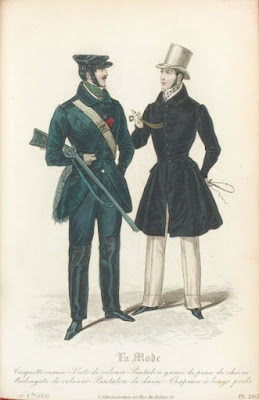I don't often post pictures of menswear, but I got hold of this little catalogue and I couldn't resist. Myer was a Melbourne-based department store (now part of the Coles Myer group). It issued these catalogues twice-yearly for its country customers. They didn't advertise all the goods available in Myer's city store, but they did list a representative sample. Here are some of the clothes offered to the well-dressed man of 1949.
A selection of overcoats in a choice of navy velour
coating or grey, brown, fawn check tweeds. The one on the far right is "fully lined
with art. Silk"—ie. rayon.
Shirts, striped and plain, in shades of blue, grey and fawn. (The last shirt on the right also came in aqua, gold tan, dark blue green and maple cream.) The first shirt has old-fashioned detachable collars and cuffs (extras supplied) but the rest of the shirts in this illustration are modern-style "coat" shirts with attached collars.
(I used to think that until the late 1960s men only wore
plain white shirts, or plain blue work shirts.
Clearly I was wrong! The men
shopping from this catalogue had a range of colours and patterns to choose
from. Many of them would have worn a
similar palette in the Army, Navy or Air Force a few years earlier.)
SPORTSWEAR FOR AUTUMN AND WINTER
At far left:
Stylish Tweed Sports Suits, Single or double-breasted,
self-supporting trousers. Perfectly cut
and fitting. Fawns, browns, grey,
grey-green, blue-grey.
(Random thought that shot through my head when I read
“self-supporting trousers”: isn’t it great when your pants can hold down a
job! Presumably the copywriter meant
that they didn’t need braces to hold them up.)
At top:
MEN’S SUPERBLY TAILORED SPORTS JACKETS.
...In a selection of checks and tweeds. This is the 1940s version of "smart casual"—though the fact that all the models are wearing ties makes them look formally dressed to modern eyes.
At bottom:
Sports trousers, in flannel, worsted and tweeds. The small insets show that the flies were fastened with buttons, not with zips.
MEN’S FINE SWEATERS FOR ALL OCCASIONS
100% PURE WOOL QUALITY YARNS KNIT FOR COMFORT, LOOKS AND WEAR
On the right are two heavyweight ribbed pullovers—with V- or roll neck—in grey, maroon, kasha, navy and brown. On the right is a cardigan in "Fancy Jacquard, all wool. The favorite of men who want good looks plus
warm, easy comfort. Fawn/Brown, dark
grey, light grey, green/grey." And once again, two of the models are wearing ties, even with casual attire.



























